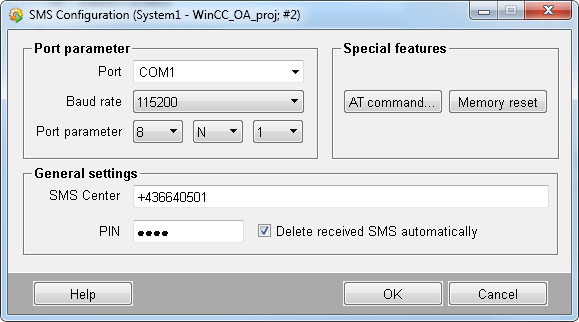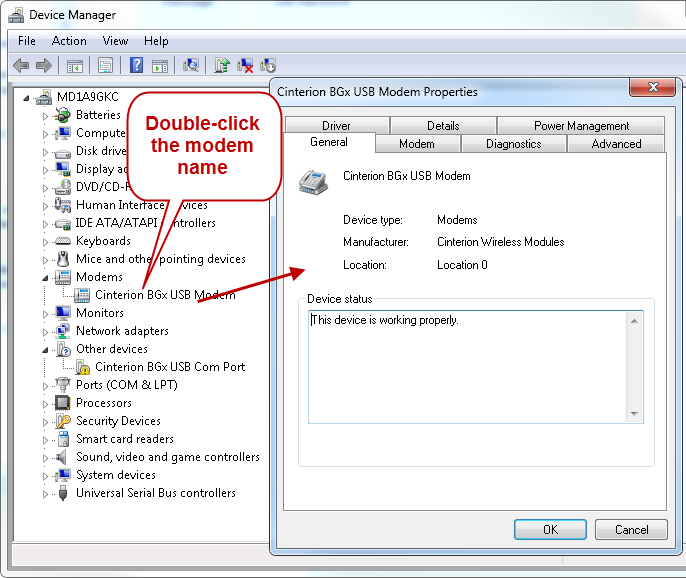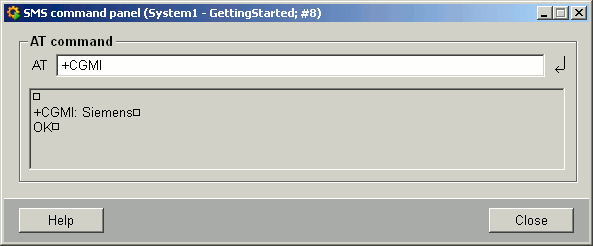SMS Configuration
The configuration panel shown in the following figure is opened via the Receive SMS panel.

The SMS configuration panel consists of three areas:
Port parameter
Port parameters comprise the combo boxes:
- Port: Choose the communication port you want to connect your device to.
USB: You can choose between COM1...to COM4.. If you use the USB port in order to connect the modem, configure the settings in addition to the panel above, also in the Control Panel -> Device Manager/Modems section. Configure also the COM ports in the same section.
In order to configure the modem via the USB port, a driver for the modem CT63 NG is needed. You can download the driver under https://www.telit.com/evkevb-drivers/. You can find further information also under http://www.telic.de/de/download/m2m-terminals-de. After installing the driver, the CT63 NG is shown under modems in the device manager (see figure below). Configure there also all other settings such as baud rate and COM port. CAUTION: The settings such as COM port and baud rate of the WinCC OA SMS Configuration panel MUST correspond to the settings in the Control panel. See the example further below in this chapter.
- In case of a COM port allocation via the operating system (e.g. infrared connection) you can also enter another COM port (e.g. COM5) manually

- Baud rate : Choose the speed from the computer (serial interface) to the device (modem or cell phone). You can find the information on the speed settings in the user manual of your device.
- Port parameter : The first combo box defines the data bits, the second the parity (Even, Odd, Marking or None) and the last the stop bits (1, 1.5 or 2).
General settings
General settings comprise the settings for "SMS center", "PIN" and "Automatic deletion of received SMS":
- SMS Center: Enter the number of the SMS center (which is provided by the ServiceProvider). You can find the number in your cell phone or on the homepage of your provider. Note that the number has to be typed in the format + country code, provider number e.g. +43676... for Austria.
- PIN is a four-digit code made available by the provider and needed if it is not saved in the device and is requested when you send or receive SMS messages for the first time. Once you have saved the PIN code, you do not have to type it again.
- The check box Automatic deletion of received SMS: Deletes the messages from the cell phone or modem automatically when WinCC OA has received the SMS message.
Special features
Special features comprises the buttons:
- Manual AT-command... Opens the SMS command panel. In the panel you can execute AT commands. AT commands are used to control and configure modems. AT commands are also
used for connection establishment between modems. All commands begin with the letters "AT". There are general AT commands and device (manufacturer) specific commands. In the AT
command panel, the AT commands are used to test if the connection to the modem was established. You can find out e.g. the manufacturer ID of the connected device by using the
command +CGMI.
See the manual of your device for more information on the different commands. To execute the command, press Enter. The command is disposed to a holding stack and executed as soon as possible.

- Memory reset. Resets the memory of the device after a security check (The memory of the cells is set to unassigned). This prevents the overflow of the device memory (An overflow of memory could prevent the sending of SMS messages).
Example
This example shows you the necessary steps to send an SMS via a USB modem. The settings in the Control panel are only necessary for a USB modem.
In order to proceed as shown in this example, read the chapter Requirements and installation and configure the settings described in that chapter.
- Open the SMS configuration panel and configure the settings as shown in the figure below. The settings were described further above in this chapter.
- In order to configure the modem CT63 NG via the USB port, a driver for the modem CT63 NG is needed. See the description of Port.
- Configure the settings in the Control panel as shown in the figure below. Take care that the settings of the SMS Configuration panel correspond to the settings in the Control panel.
- Confirm the settings. Now you can send an SMS, see step 5 below the figure.

- Click on the Send... button in the "Receive SMS" panel (see figure below). Type the telephone number and the message into the "Send SMS panel" and click on "Send" (see figure below)
- The SMS is sent.




